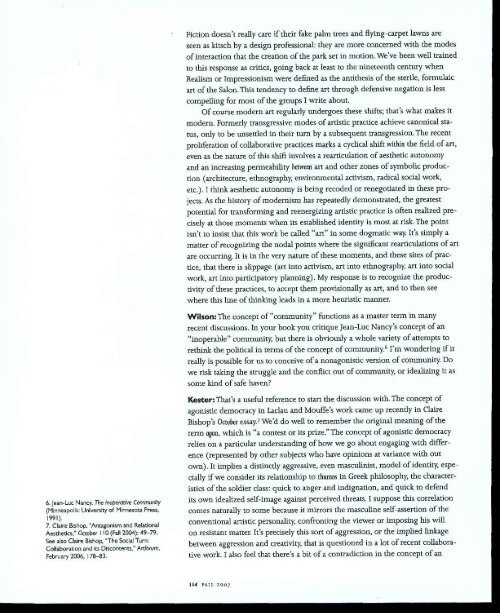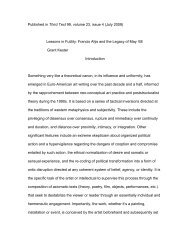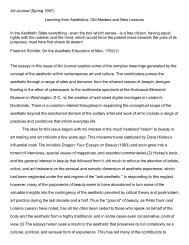Art Journal interview with Mick Wilson - Grant Kester
Art Journal interview with Mick Wilson - Grant Kester
Art Journal interview with Mick Wilson - Grant Kester
Create successful ePaper yourself
Turn your PDF publications into a flip-book with our unique Google optimized e-Paper software.
6. Jean-Luc Nancy, The Inoperative Community<br />
(Minneapolis: University of Minnesota Press,<br />
1991).<br />
7. Claire Bishop, "Antagonism and Relational<br />
Aesthetics," October I 10 (Fall 2004): 49-79.<br />
See also Claire Bishop, "The Social Turn:<br />
Collaboration and its Discontents," <strong>Art</strong>forum,<br />
February 2006, 178-83.<br />
Fiction doesn't really care if their fake palm trees and flying-carpet lawns are<br />
seen as kitsch by a design professional: they are more concerned <strong>with</strong> the modes<br />
of interaction that the creation of the park set in motion. We've been well trained<br />
to this response as critics, going back at least to the nineteenth century when<br />
Realism or Impressionism were defined as the antithesis of the sterile, formulaic<br />
art of the Salon. This tendency to define art through defensive negation is less<br />
compelling for most of the groups I write about.<br />
Of course modern art regularly undergoes these shifts; that's what makes it<br />
modern. Formerly transgressive modes of artistic practice achieve canonical status,<br />
only to be unsettled in their turn by a subsequent transgression. The recent<br />
proliferation of collaborative practices marks a cyclical shift <strong>with</strong>in the field of art,<br />
even as the nature of this shift involves a rearticulation of aesthetic autonomy<br />
and an increasing permeability between art and other zones of symbolic production<br />
(architecture, ethnography, environmental activism, radical social work,<br />
etc.). I think aesthetic autonomy is being recoded or renegotiated in these projects.<br />
As the history of modernism has repeatedly demonstrated, the greatest<br />
potential for transforming and reenergizing artistic practice is often realized precisely<br />
at those moments when its established identity is most at risk. The point<br />
isn't to insist that this work be called "art" in some dogmatic way. It's simply a<br />
matter of recognizing the nodal points where the significant rearticulations of art<br />
are occurring. It is in the very nature of these moments, and these sites of practice,<br />
that there is slippage (art into activism, art into ethnography, art into social<br />
work, art into participatory planning). My response is to recognize the productivity<br />
of these practices, to accept them provisionally as art, and to then see<br />
where this line of thinking leads in a more heuristic manner.<br />
<strong>Wilson</strong>: The concept of "community" functions as a master term in many<br />
recent discussions. In your book you critique Jean-Luc Nancy's concept of an<br />
"inoperable" community, but there is obviously a whole variety of attempts to<br />
rethink the political in terms of the concept of community.' I'm wondering if it<br />
really is possible for us to conceive of a nonagonistic version of community. Do<br />
we risk taking the struggle and the conflict out of community, or idealizing it as<br />
some kind of safe haven?<br />
<strong>Kester</strong>: That's a useful reference to start the discussion <strong>with</strong>. The concept of<br />
agonistic democracy in Laclau and Mouffe's work came up recently in Claire<br />
Bishop's October essay. 7 We'd do well to remember the original meaning of the<br />
term agon, which is "a contest or its prize." The concept of agonistic democracy<br />
relies on a particular understanding of how we go about engaging <strong>with</strong> difference<br />
(represented by other subjects who have opinions at variance <strong>with</strong> out<br />
own). It implies a distinctly aggressive, even masculinist, model of identity, especially<br />
if we consider its relationship to thumos in Greek philosophy, the characteristics<br />
of the soldier class: quick to anger and indignation, and quick to defend<br />
its own idealized self-image against perceived threats. I suppose this correlation<br />
comes naturally to some because it mirrors the masculine self-assertion of the<br />
conventional artistic personality, confronting the viewer or imposing his will<br />
on resistant matter. It's precisely this sort of aggression, or the implied linkage<br />
between aggression and creativity, that is questioned in a lot of recent collaborative<br />
work. I also feel that there's a bit of a contradiction in the concept of an<br />
114 FALL 2007




